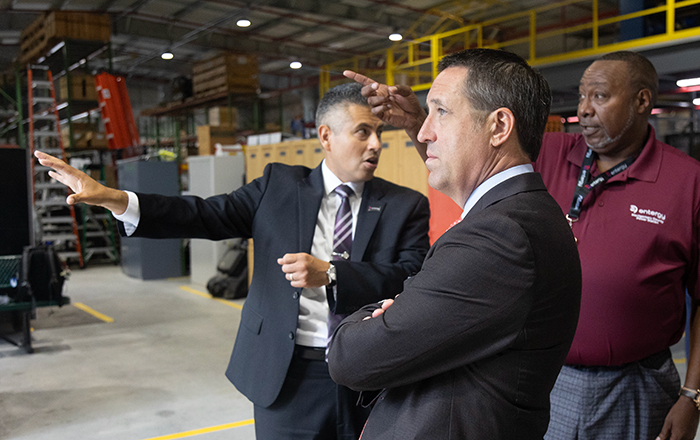From the Desk of Glenn Hegar:Comptroller Hegar cites critical importance of energy infrastructure
Texas voters approve Texas Energy Fund
February 2024
Texas voters overwhelmingly approved Proposition 7 on Nov. 7, 2023, to create the Texas Energy Fund (TEF), which was allocated $5 billion by the 88th Legislature to support the construction, maintenance, modernization and operation of electric generation facilities. Comptroller Glenn Hegar’s Texas Treasury Safekeeping Trust Company is responsible for investing the fund in a manner consistent with the Public Utility Commission’s (PUC) administration.
Read more about Proposition 7
The PUC is charged with implementing the process for entities to apply for and receive money from the TEF. The initiative provides for 3 percent interest rate loans for new dispatchable generation projects (covering up to 60 percent of a project’s cost) and completion bonus grants for new dispatchable generation built before June 1, 2029. (Generation is dispatchable if human forces control energy output; however, energy storage projects are not eligible for the TEF programs described above.)
The TEF legislation also includes a new Texas Backup Power Package program, which can support smaller generation stations that provide at least 48 hours of backup generation at facilities critical to community welfare. Lastly, TEF grants are available to modernize and strengthen electric infrastructure in regions of the state outside of the ERCOT grid.
Hegar has emphasized the critical importance of ensuring the soundness and sufficiency of Texas’ energy infrastructure through moves including his Good for Texas Tour: Energy Edition, and he spoke out in favor of Proposition 7. The text that follows is the Comptroller’s excerpted from the Desk of Glenn Hegar piece that originally appeared in the Dallas Morning News.

As we turn from an unbearably hot summer to face the coming winter storm season, energy is at the top of my mind, and not because of so-called extreme weather challenges. Whatever the season, our state continues to grow by leaps and bounds, adding almost 1,300 people a day, according to census data, with three-fourths of them moving here and the rest Texan by birth. Predictions are that the 2040s probably will see us grow bigger than California.
As Texas’ chief financial officer, I want to help keep our economy strong by ensuring our energy infrastructure meets the needs of new and expanding businesses and of citizens chasing their dreams. To put a sharp focus on Texas’ need for a long-term, diverse, reliable power plan, I just finished crossing the state during my “Good for Texas Tour: Energy Edition.” My tour brought home the possibility of a shortfall in readily available energy. That’s a vulnerability that has me more concerned than any other challenge facing our state.
My tour focused on the breadth of our energy resources and the still-existing need, and my agency’s research covered our key types of generation, infrastructure, maintenance and support — including the trained, skilled workforce we need to fill good energy jobs. I also visited the Electric Reliability Council of Texas (ERCOT), which oversees electric service for 90% of the state, including more than 26 million customers.
We continue to hear about challenges in getting people to invest in fossil fuels because too often renewables are seen as the only solution.
Of course, we need diverse energy sources; I would no more want to put all our eggs in one basket when it comes to our energy supply than I would when it comes to the multitude of investments that my office handles for our state. I am pleased that Texas is the nation’s leading producer of wind-powered electricity, yet renewable energy production has also made our electric grid much more complex and extremely difficult for ERCOT to manage.
It is very evident that fossil fuels will and must remain a crucial part of our energy portfolio for the foreseeable future. More than 60% of the nation’s electricity generation came from fossil fuels in 2022, including nearly 40% from natural gas, according to the U.S. Energy Information Administration. Texas plays an important role in the national energy picture: We’re No. 1 in energy consumption and production, and we produce more energy than we use. That makes us the biggest net supplier of energy to the United States; we provide almost one-quarter of our country’s domestically produced energy.
I am convinced that renewable energy production will be a part of Texas’ economic future and that our daily lives are as much or more interconnected to the oil and gas industry than ever before. One will not exist without the other, and to think otherwise is not based on economic reality.
I am paying closer attention to our energy challenges, as the stakes for Texas’ economic future are so high. According to data from ERCOT, about 41% of Texas’ thermal power generation — natural gas, nuclear and coal power — comes from facilities that are more than three decades old. That’s when the original Jurassic Park came out; it’s not a stretch to say some of these facilities are dinosaurs.
We have a range of other energy challenges, such as a shortage of electrical distribution transformers and an ever-increasingly complex energy market that includes, for example, energy-consuming data centers.
We simply don’t have sufficient readily dispatchable energy for the days when renewables aren’t doing what we need them to do. The proposition is not the full answer to our energy needs, but it is an important piece of the puzzle as we work to strengthen our infrastructure.
We must deal with the new complexities of our energy market, the aging dispatchable fleet, increased workforce shortages and supply chain constraints, along with the challenge of weather extremes and the demands of growth for the Texas economy to prosper. To do so means making forward-looking investments in our energy infrastructure, as smart investments in energy are investments in our state’s future.
Access more Comptroller from the desk of glenn hegar content in our media center.


